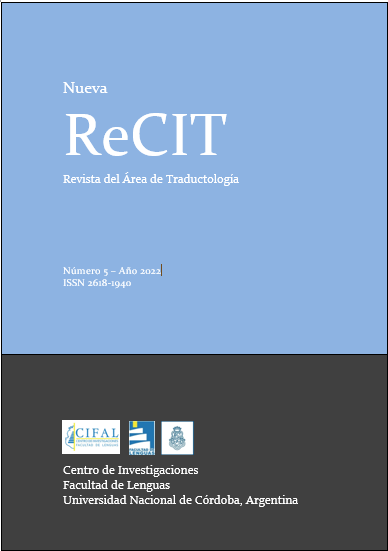El análisis de la modalidad de enunciado en verbos modales de una novela del género policial para lograr una traducción homóloga del inglés al español. Estudio contrastivo inglés-español
Palabras clave:
modalidad, traducción, verbos modalesResumen
La modalidad ha sido tradicionalmente objeto de estudio tanto de la lógica como de las ciencias del lenguaje, y dentro de estas últimas, reviste gran interés para la traductología. En primer lugar, es importante recordar que no toda lengua tiene un sistema modal, pero eso no significa que carezca de los medios para expresar la modalidad. De hecho, los hablantes contamos con diversos tipos de expresiones modales, como colocaciones modales de verbos-adverbio (Hoye, 1997), verbos modales plenos (Matthews, 1991), semimodales y modales emergentes (Krug, 2000; Mitchell, 2003; Hoye, 2005b), entre otras combinaciones y denominaciones. Sin embargo, dada la variedad de opciones ofrecidas por las lenguas, en el presente estudio nos proponemos investigar solo un elemento portador de modalidad en lengua inglesa, a saber, los verbos auxiliares modales. El interés en esta categoría en particular deriva de la significativa diferencia en número y variedad de verbos modales en inglés si se los compara con los que ofrece el español, como así también de los casos frecuentes de ambigüedad que nos desafían como profesionales de la traducción (Rosa Rabadán, 2006). Asimismo, en los casos en que, en apariencia, no habría problemas de diferencias de recursos formales disponibles entre lenguas, es importante repensar cada caso en contexto al ejercer nuestra labor traductora dado que la carga semántica que los verbos modales poseen en el texto original en inglés no siempre coincide con la que portarían los equivalentes sugeridos por herramientas como los diccionarios (Rabadán, 2006). De hecho, sabemos que verbos como poder y deber parecen corresponderse directamente con los modales del inglés can y must para indicar posibilidad y obligación respectivamente, pero en algunos casos no es así. Por todo lo expuesto, en el presente proyecto de tesis de maestría se propone abordar el problema de la traducción de los verbos modales del inglés al español a través del análisis contrastivo de fragmentos de una novela policial contemporánea con la finalidad de describir algunas de las opciones a disposición de los traductores para resolver el problema que nos ocupa.
Referencias
Abdul-Fatttah, H. (2011). A Formal-Functional Analysis of the English Modal Auxiliaries. Jordan Journal of Modern Languages and Literature, 3(1), 39-63.
Bally, C. (1942). Syntaxe de la modalité explicite. En Société Genoveise de Linguistique (Ed.), Cahiers de Ferdinand de Saussure (pp. 3-13). Ginebra, Suiza: Librairie Droz.
Ferrari, L. (2009). Marcadores de modalidad epistémica y evidencial en el análisis de las conclusiones de artículos de investigación de disciplinas distintas. Revista latinoamericana de estudios del discurso, 9 (2), 5-23.
Hoye, L.F. (1997). Adverbs and Modality in English. Londres, Inglaterra/Nueva York, Estados Unidos: Longman.
Hoye, L.F. (2005a). ‘May Think That; I Couldn’t Possibly Comment!’ Modality Studies: Contemporary Research and Future Directions. Part I. Journal of Pragmatics, 37(8), 1295-1321.
Hoye, L.F. (2005b). ‘You May Think That; I Couldn’t Possibly Comment!’ Modality Studies: Contemporary Research and Future Directions. Part II. Journal of Pragmatics 37(9), 1481-1506.
Hurtado Albir, A. (2001). Traducción y traductología. Introducción a la traductología. Madrid, España: Cátedra.
Krug, M. (2000). Emerging English Modals: A Corpus-Based Study of Grammaticalization. Berlín, Alemania/Nueva York, Estados Unidos: Mouton de Gruyter.
Maingueneau, D. (1980). Introducción a los métodos de análisis del discurso. Buenos Aires, Argentina: Hachette.
Matthews, R. (1991). Words and Worlds: On the Linguistic Analysis of Modality. Berlín, Alemania: Peter Lang.
Miranda de Torres, S. (1997). Los verbos modales en inglés, francés y español. Estudio contrastivo. (Tesis inédita de Especialización Lingüística). Escuela Superior de Lenguas, Córdoba, Argentina.
Mitchell, K. (2003). “Had better and might as well: On the margins of modality” en Modality in Contemporary English, Roberta Facchinetti, Frank Palmer & Manfred Krug (eds.), 129-150. Berlin/New York: Mouton de Gruyter. DOI: https://doi.org/10.1515/9783110895339.129
Nord, Christiane (2009). El funcionalismo en la enseñanza de traducción (en línea) Mutatis Mutandis, 2 (2), 209-243. Recuperado de http://aprendeenlinea.udea.edu.co/revistas/index.php/mutatismutandis/article/viewFile/ 2397/2080.
Palmer, F.R. (1979). Modality and the English Modals. Londres, Inglaterra/Nueva York, Estados Unidos: Longman.
Palmer, F.R. (1986). Mood and Modality. Cambridge, Inglaterra: Cambridge University Press.
Palmer, F.R. (1990). Modality and the English Modals .2da edición. Londres, Inglaterra/Nueva York, Estados Unidos: Longman.
Palmer, F.R. (2001). Mood and Modality. 2da edición. Cambridge, Inglaterra: Cambridge University
Press.
Rabadán, R. (2006). Modality and modal verbs in contrast. Mapping out a translation(ally) relevant approach English-Spanish. Languages in Contrast, 6(2), 261-306.
Real Academia Española. (2009) Nueva gramática de la lengua española. Manual. Madrid, España: Espasa.
Van Dover, J. K. (2005). We must have certainty. Four essays on the detective story. Cranbury, Estados Unidos: Rosemont Publishing & Printing Corp.
Publicado
Número
Sección
Licencia

Esta obra está bajo una licencia internacional Creative Commons Atribución-NoComercial-SinDerivadas 4.0.
Aquellos autores que deseen publicar en Nueva ReCIT aceptan los siguientes términos:
• Los autores conservarán sus derechos sobre el texto entregado y garantizarán a la revista el derecho de primera publicación de su obra. Dicho derecho estará simultáneamente sujeto a la licencia Creative Commons, la cual permite que terceros compartan la obra siempre que
se mencione al autor y al lugar de la primera publicación.
• Los autores realizan una cesión de derechos no exclusivos, lo que implica que la publicación de los artículos en Nueva ReCIT no impide al autor publicar su texto, a posteriori, en otras revistas u órganos editoriales; asimismo, los autores autorizan que el trabajo sea depositado en repositorios institucionales, como el Portal de Revistas de la Universidad Nacional de Córdoba o el Repositorio Digital de la Universidad Nacional de Córdoba.

